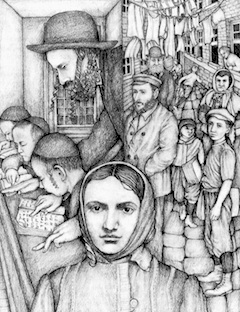|
J. William T. "Bill" Youngs, American Realities, Volume Two:
Historical Episodes from Reconstruction to the Present, Chapter Five |
Russian Jews and Ellis Island -- original drawing by Cecily Moon for the first edition of American Realities
|
5. New Immigrants
|
SummaryAmerica has long been a place of refuge for the outcasts of other lands. Puritans fleeing religious persecution and Irish families escaping famine immigrated to the New World to begin their lives anew. Waves of immigrants from northern Europe peopled the United States in the early years, but the greatest influx came during the years 1880 to 1915 when millions of people from eastern and southern Europe came to America and created ethnic communities. The Russian Jews and other immigrants faced many hardships in the United States, but none more difficult than maintaining their cultural identity in an America that both stimulated and undermined their traditional ways.
|
Author reads from the Text
The life of the Russian Jew with its mixture of hardship and triumph is told in the story of a girl who migrated from the Pale to the United States. After a few years of life in the New World she decided to write an account of her youth, not, as she indicated in her preface, because it was unique, but because it was “typical of many.” Her American name was Mary Antin, and the title of her book was The Promised Land.
Mary was born in Polotzk, a village some three hundred miles west of Moscow. Her father was a prosperous merchant who provided well for his family: his daughter remembered embroidered linen, silver candlesticks, kitchen shelves “lined with copper and brass,” and “featherbeds heaped halfway to the ceiling.” It was a world in which matchmakers arranged marriages, and people wore a ribbon around the neck to ward off disease. Above all, it was a world tinctured by the Jewish faith. Religion touched almost every corner of Mary’s life. Whenever her mother discovered a peculiar mark on a chicken she was preparing to cook, she would send it to the rabbi, who would “look in his big books” and decide whether the chicken could be eaten. The Antins observed the Sabbath with a rigor that even the early American Puritans could not have matched. On the Sabbath, Mary was not allowed to work or even to touch any instrument of labor or commerce, such as an ax or a coin. It was “forbidden to light a fire, or to touch anything that contained a fire, or had contained fire, were it only a cold candlestick or a burned match.”
As a little girl Mary learned that “The world was divided between Jews and Gentiles.” A girl named Vanka threw mud at her; her mother brushed off the dirt and explained that there was nothing to do because Vanka was a Gentile, and “The Gentiles do as they like with us Jews.” Mary learned quickly, and later when Vanka spat at her she wiped her face and, she writes, “thought nothing at all. I accepted ill-usage from the Gentiles as one accepts the weather.”
Mary was born in Polotzk, a village some three hundred miles west of Moscow. Her father was a prosperous merchant who provided well for his family: his daughter remembered embroidered linen, silver candlesticks, kitchen shelves “lined with copper and brass,” and “featherbeds heaped halfway to the ceiling.” It was a world in which matchmakers arranged marriages, and people wore a ribbon around the neck to ward off disease. Above all, it was a world tinctured by the Jewish faith. Religion touched almost every corner of Mary’s life. Whenever her mother discovered a peculiar mark on a chicken she was preparing to cook, she would send it to the rabbi, who would “look in his big books” and decide whether the chicken could be eaten. The Antins observed the Sabbath with a rigor that even the early American Puritans could not have matched. On the Sabbath, Mary was not allowed to work or even to touch any instrument of labor or commerce, such as an ax or a coin. It was “forbidden to light a fire, or to touch anything that contained a fire, or had contained fire, were it only a cold candlestick or a burned match.”
As a little girl Mary learned that “The world was divided between Jews and Gentiles.” A girl named Vanka threw mud at her; her mother brushed off the dirt and explained that there was nothing to do because Vanka was a Gentile, and “The Gentiles do as they like with us Jews.” Mary learned quickly, and later when Vanka spat at her she wiped her face and, she writes, “thought nothing at all. I accepted ill-usage from the Gentiles as one accepts the weather.”

